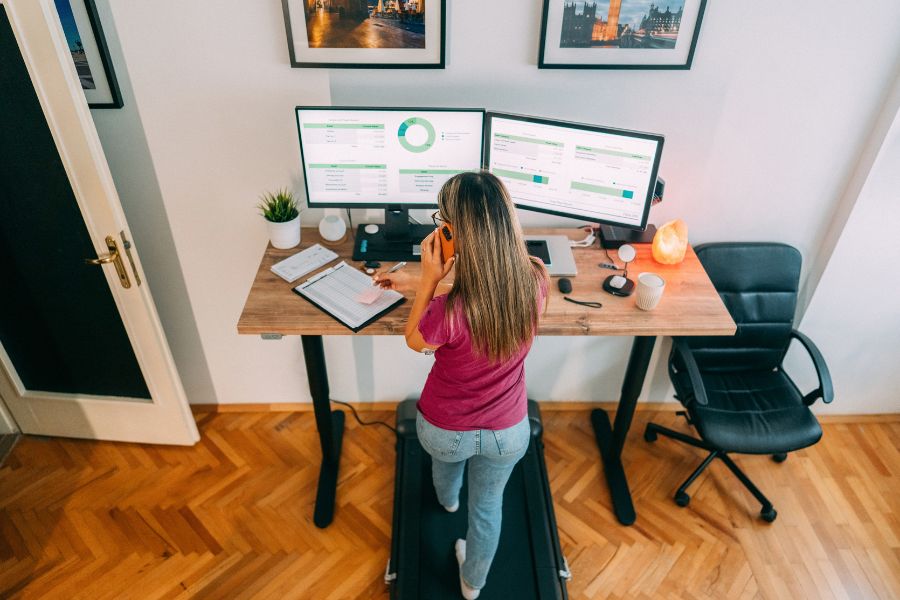As remote work becomes increasingly common, many professionals are reevaluating their home office setups to prioritize health and productivity. One of the most debated topics is whether a standing desk or a sitting desk is better for remote workers.
Both options have their advocates, and each comes with its own set of benefits and drawbacks. This article will compare standing desks and sitting desks in terms of health impacts, productivity, cost, and ergonomics.
By the end, you’ll have a clear understanding of which option might be healthier and more suitable for your remote work lifestyle.
1. The Importance of Ergonomics in Remote Work
Before diving into the comparison, it’s essential to understand why ergonomics matters for remote workers. Poor posture and prolonged sitting or standing can lead to a host of health issues, including back pain, neck strain, and circulatory problems.
A well-designed workspace can help mitigate these risks and improve overall well-being.
- Posture: Proper alignment reduces strain on muscles and joints.
- Movement: Alternating between sitting and standing promotes circulation and reduces stiffness.
- Comfort: A comfortable workspace enhances focus and productivity.
Choosing the right desk is a crucial step in creating an ergonomic home office.
2. The Case for Standing Desks

Standing desks have gained popularity in recent years as a healthier alternative to traditional sitting desks. They allow users to work while standing, which can reduce the risks associated with prolonged sitting.
Let’s explore the advantages of standing desks for remote workers.
2.1 Reduced Risk of Sedentary Behavior
Prolonged sitting has been linked to various health issues, including obesity, cardiovascular disease, and diabetes. Standing desks encourage movement and reduce sedentary behavior.
- Increased Calorie Burn: Standing burns more calories than sitting, aiding in weight management.
- Improved Circulation: Reduces the risk of blood clots and varicose veins.
2.2 Better Posture
Standing desks can promote better posture by encouraging users to engage their core muscles and maintain a neutral spine.
- Alignment: Reduces slouching and forward head posture.
- Muscle Engagement: Strengthens core and leg muscles over time.
2.3 Enhanced Energy and Focus
Many users report feeling more energetic and focused when using a standing desk, which can boost productivity.
- Alertness: Standing can help combat midday fatigue.
- Mood Improvement: Increased movement can elevate mood and reduce stress.
2.4 Customizable Height
Many standing desks are adjustable, allowing users to switch between sitting and standing positions throughout the day.
- Flexibility: Adapt the desk to your preferred height and work style.
- Variety: Alternating between sitting and standing can reduce fatigue.
3. The Challenges of Standing Desks
While standing desks offer many benefits, they also come with challenges, such as discomfort and higher costs. Let’s examine these drawbacks.
3.1 Potential Discomfort
Standing for long periods can lead to discomfort, particularly in the feet, legs, and lower back.
- Fatigue: Prolonged standing can cause muscle soreness and joint pain.
- Anti-Fatigue Mats: May be necessary to reduce discomfort.
3.2 Higher Cost
Standing desks, especially adjustable models, are generally more expensive than traditional sitting desks.
- Premium Features: Advanced mechanisms and materials contribute to the higher cost.
- Budget Constraints: May not be feasible for all remote workers.
3.3 Space Requirements
Standing desks can be bulkier and require more space than sitting desks, which can be a challenge in smaller home offices.
- Footprint: Ensure you have enough room for the desk and any additional accessories.
- Setup: May require more effort to assemble and adjust.
3.4 Adaptation Period
Transitioning to a standing desk can take time, and some users may experience initial discomfort or difficulty adjusting.
- Gradual Transition: Start with short periods of standing and gradually increase.
- Patience: Allow your body time to adapt to the new setup.
4. The Case for Sitting Desks

Sitting desks are the traditional choice for home offices and offer several advantages, particularly for those who prefer a more conventional work setup. Let’s explore the benefits of sitting desks for remote workers.
4.1 Comfort and Familiarity
Sitting desks are familiar and comfortable for most people, making them an easy choice for remote work.
- Ease of Use: No need to adjust to a new way of working.
- Support: Chairs with proper lumbar support can enhance comfort.
4.2 Lower Cost
Sitting desks are generally more affordable than standing desks, making them accessible to a wider audience.
- Budget-Friendly: Suitable for those with limited funds.
- Variety of Options: Available in a range of styles and prices.
4.3 Space Efficiency
Sitting desks are often more compact and easier to fit into smaller spaces, making them ideal for home offices.
- Minimal Footprint: Requires less room than a standing desk.
- Simple Setup: Easy to assemble and arrange.
4.4 Reduced Fatigue
Sitting desks allow users to work without the physical strain of standing for long periods.
- Less Strain: Reduces fatigue in the legs and feet.
- Comfortable Seating: Proper chairs can provide excellent support.
5. The Challenges of Sitting Desks
While sitting desks are comfortable and affordable, they also come with health risks, particularly when used for extended periods. Let’s examine these drawbacks.
5.1 Health Risks of Prolonged Sitting
Prolonged sitting has been linked to various health issues, including obesity, cardiovascular disease, and musculoskeletal problems.
- Sedentary Lifestyle: Increases the risk of chronic conditions.
- Poor Circulation: Can lead to swelling and blood clots.
5.2 Poor Posture
Sitting for long periods can lead to poor posture, particularly if the desk and chair are not ergonomically designed.
- Slouching: Can cause back and neck pain.
- Forward Head Posture: Increases strain on the cervical spine.
5.3 Reduced Energy Levels
Sitting for extended periods can lead to feelings of fatigue and decreased energy levels.
- Midday Slump: Common among those who sit for long hours.
- Lethargy: Can reduce productivity and focus.
5.4 Limited Movement
Sitting desks restrict movement, which can lead to stiffness and discomfort over time.
- Inactivity: Reduces opportunities for stretching and movement.
- Stiffness: Can cause joint and muscle pain.
6. Key Factors to Consider
When choosing between a standing desk and a sitting desk for your home office, consider the following factors to make an informed decision.
6.1 Health Goals
Your health goals will play a significant role in determining which type of desk is best for you.
- Active Lifestyle: Choose a standing desk if you want to reduce sedentary behavior.
- Comfort: Opt for a sitting desk if you prioritize comfort and support.
6.2 Budget
Your budget will influence whether you can afford a standing desk or need to opt for a sitting desk.
- High Budget: Invest in an adjustable standing desk for flexibility.
- Low Budget: A sitting desk offers a cost-effective solution.
6.3 Workspace Size
The size of your home office will impact your choice of desk.
- Small Space: A sitting desk may be more practical.
- Larger Space: A standing desk can fit comfortably.
6.4 Work Habits
Consider your work habits, such as how long you typically work and whether you prefer to sit or stand.
- Long Hours: Alternating between sitting and standing can reduce fatigue.
- Short Hours: A sitting desk may suffice if you don’t work for extended periods.
7. Key Takeaways and Recommendations
Deciding between a standing desk and a sitting desk for your home office depends on your specific needs and preferences. Here are some key takeaways and recommendations to help you choose.
- Choose a Standing Desk If: You want to reduce sedentary behavior, improve posture, and boost energy levels.
- Choose a Sitting Desk If: You prioritize comfort, affordability, and a traditional work setup.
- Consider a Hybrid Approach: Use an adjustable desk to alternate between sitting and standing throughout the day.
Conclusion
The choice between a standing desk and a sitting desk for remote work ultimately depends on your health goals, budget, and workspace size.
Standing desks offer numerous health benefits, including reduced sedentary behavior and improved posture, but they can be more expensive and require an adaptation period. Sitting desks are comfortable, affordable, and space-efficient but come with health risks associated with prolonged sitting.
By carefully evaluating your priorities and testing different options, you can create a home office setup that promotes health, comfort, and productivity.
